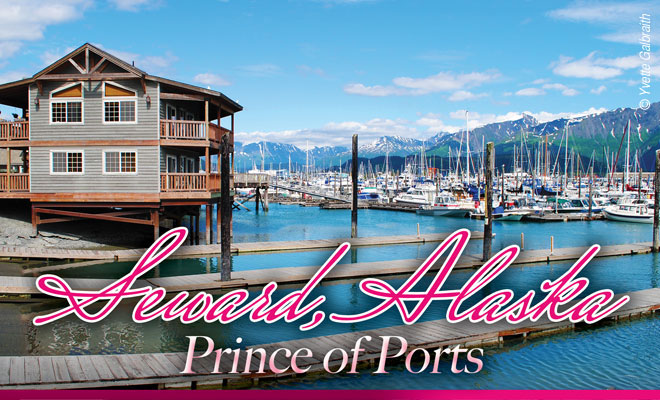
SEWARD, ALASKA: Prince of Ports
Alaska is filled with beautiful places. Most of those beautiful places offer exceptional fishing of one sort or another. But there are few places in Alaska that compare with the downright stunning natural beauty on offer near the port city of Seward. And the saltwater fishing likewise on offer here is second to none, making Seward one of the state’s crown jewels for Alaska travelers and residents alike, all of whom flock to the area each summer to take part in any number of outdoor activities—but mostly to fish.
By Troy Letherman
Quaint and charming, yet featuring all the modern conveniences expected of a 21st century tourist hub, Seward sits perched at the head of Resurrection Bay and is well known for its great saltwater angling, as well as its outstanding sightseeing opportunities for both natural scenery such as the region’s many glaciers and the variety of marine mammals on display. Then there are plenty of other tourist events and attractions unique to the town, such as Mount Marathon and the Alaska SeaLife Center, making Seward an ideal stop to lock into your next travel itinerary.
Located just 120 miles south of Anchorage at the end of the Seward Highway Scenic Byway, this sport-fishing hub is easy to get to and caters to a wide range of interests, from eco-adventures to hardcore angling, all of which adds up to create just about the perfect Alaska destination.
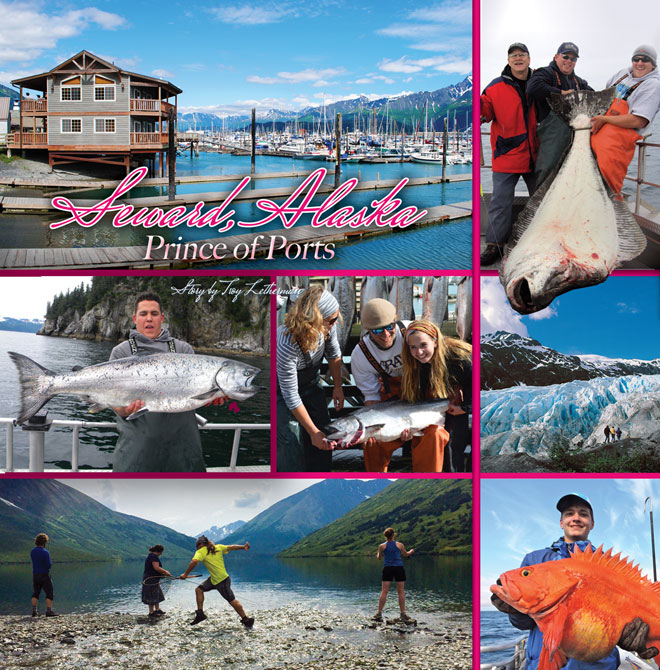
Clockwise from top: The Seward Boat harbor. © Yvette Galbraith. Tim Berg with a derby-winning halibut. © Tim Berg’s Alaskan Fishing Adventures. Taking an Exit Glacier tour. © Seward Windsong Lodge. A yelloweye like this is a fish of a lifetime. © Alaska Northern Outfitters. Here’s a guide getting after it! There is freshwater fishing also available right around Seward. © Dragon Fly fishing Guides. Nice dime bright saltwater king out of Seward. © Tim Berg’s Alaskan Fishing Adventures. Seward is well known as a mecca for silvers and smiling anglers. © Aurora Charters.
The Fishing
Known far and wide as hosting one of the greatest saltwater silver salmon fishing grounds in the world, the waters of Resurrection Bay and beyond into Prince William Sound provide anglers with unrivalled opportunity to target chrome-bright coho as they push through the sound and into the bay, headed for the freshwater streams and lakes beyond. But silvers are far from the only show in town, as boats from Seward also troll, drift and mooch through some of Alaska’s best trophy halibut and lingcod waters, as well as plenty of prime rockfish territory, including coveted yelloweye rockfish. There is also some prime king salmon fishing to be had, namely in the migration corridors near Montague Island in Prince William Sound.
Anglers visiting Seward can check for charters online beforehand (www.FishAlaskaMagazine.com is a great place to start, as are any of the charters listed in the contacts with this article) and get set-up for a day’s action on the water. Seward is heavy with sport-fishing options, from rental kayaks to beach-casting, charter boats to small-boat guides, and it’s often possible to book an economical half- or full-day trip. The later in the summer the better the fishing and the bigger the fish, generally speaking, and also, the better your chance of targeting multiple species in a single excursion.
In a typical year, the first fishing of the season from Seward is centered around the halibut. At its margins, the halibut charter season will begin sometime in April and last until October, typically peaking in mid-July. Most of the better halibut grounds near Seward are actually outside Resurrection Bay, and charter operations often motor their clients to underwater reefs and pinnacles that are known quantities—areas such as the Montague Shelf out in front of Prince William Sound. This is a giant mass of area made of a sloping tabletop-type configuration with many rockpiles, pinnacles and grooves that eventually drop into the deep blue abyss. Considering that there is a major confluence of currents here—the counterclockwise rotation of the Gulf of Alaska current meeting the in-and-out tidal flushing of Prince William Sound via Montague Strait, there is a lot going on. This is an exceptional natural draw if for no other reason than current forcing both plankton and baitfish species to the area. Throw in the underwater topography, outstanding migratory lanes and countless natural “rest stops,” and you have a world-class fishery, not just for halibut but also kings.
King salmon season kicks off with runs generally starting to assemble in the waters near Montague Island in mid- to late May, and the fish can be present there up to two months. Of course the timing and numbers vary from year to year but it is safe to say that mid-June is peak. Montague horizontally shelters the inside waters of western Prince William Sound from the open Gulf of Alaska or Pacific Ocean, making it one of the reasons the sound is a sound. Here Chinook salmon bound for such famous final destinations as the Kenai and Copper rivers pass through, feed and holdover before making a last run to their natal waters.
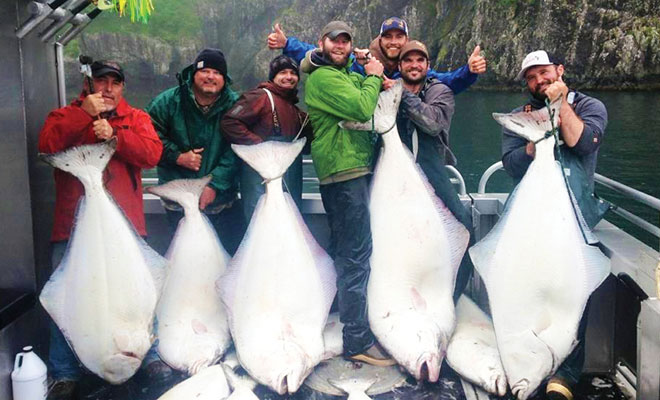
How about a halibut haul like this for your fishing experience?
© Alaska Northern Outfitters
As the season wears on, sport fishermen will begin targeting lingcod,yelloweye, black and other rockfish species, often in or near the same waters as the bulk of the halibut action takes place. The many rock pinnacles make for fantastic habitat for a variety of these bottomfish, but be sure to consult current regulations closely, as rockfish populations are managed carefully by ADF&G to protect against overfishing. By the end of June, however, most of the focus turns to silver.
Resurrection Bay supports one of the largest saltwater coho sport fisheries in the Pacific Northwest. The Alaska Department of Fish and Game has stocked silver salmon in Resurrection Bay waters since the early 1960s, in order to stabilize and increase the number of silvers available to sport anglers. The stocking program releases more than 700,000 silver salmon smolt at the Lowell Creek waterfall and in Seward Lagoon, and an additional 400,000 silver salmon fry into Bear Lake annually.
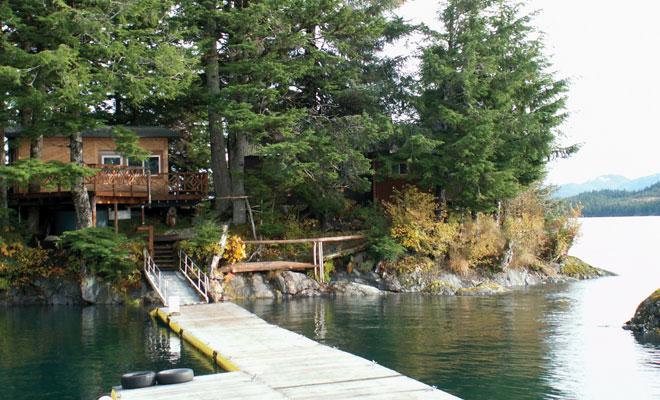
Eshamy Bay Lodge offers a remote experience. © Eshamy Bay Lodge
The area’s coho, which weigh anywhere from 6- to 20-plus pounds on average, usually begin to enter the outer areas of Resurrection Bay in the last week of June, with fishing continuing through mid-September. Make sure you buy a derby ticket before you head out on the water, however, as the Seward Silver Salmon Derby, which runs August 13-21 this year, is one of Alaska’s oldest and richest fish derbies.
During even-numbered years such as 2016, there is a decent pink salmon sport fishery available, with the species known to spawn in about a dozen freshwater streams that empty into the bay, and there is even a vibrant sockeye salmon fishery in June each year on the beaches near the mouths of Salmon Creek and Resurrection River, only a few miles down Nash Road from town. Nearly all the sockeye here are a product of the Trail Lakes Hatchery and are caught by snagging, which is a legal method as long as you are beyond the marker that officially puts you into the saltwater of Resurrection Bay.
Resurrection Bay also has small runs of wild silver salmon, but with one exception, the freshwaters of the Resurrection Bay area are closed to salmon fishing. The exception is the Resurrection River downstream of the Seward Highway and Nash Road. There’s a fall fishery for silver salmon here, using unbaited single hooks only. Silvers are typically in the Resurrection River from late August through October. Not far from Seward, there are also a variety of lakes and small streams that offer great fly-fishing potential for resident species, including trout, grayling and char, giving anglers an opportunity to pursue something a little different, and a little off the beaten path, after a few long days on the salt.
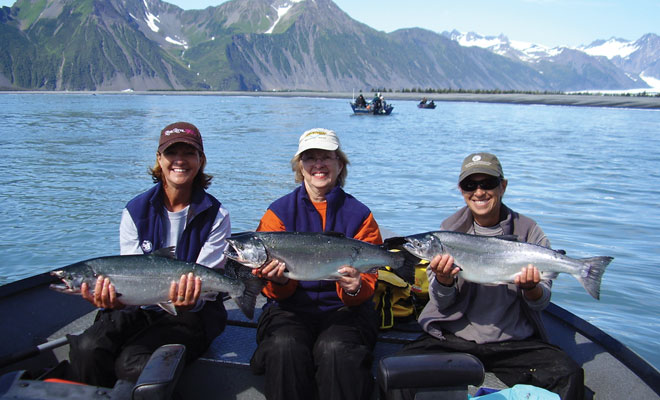
Kenai River Sportfishing provides Resurrection Bay Silver trips.
© Alaska Wildland Adventures
How to Get There
Getting to Seward is an experience by itself, as the Seward Highway National Scenic Byway and All-American Road starts here, and the drive from Anchorage is nothing short of spectacular. Winding around Turnagain Arm, the highway is bordered by the glistening waters of the arm on one side and towering mountains on the other, with other highlights including waterfalls cascading towards the road and Dall sheep standing high above.
For something a little different, you might think about hopping aboard the Alaska Railroad’s Coastal Classic Train, which presents a one-of-a-kind trip to Seward. You can relax on your journey and feel well-rested and ready for your adventure once you arrive, while also taking in plenty of sightseeing along the way. The train docks within walking distance of the Seward small-boat harbor, and if you have charter or tour reservations before you arrive, many local businesses will meet you at the station for true door-to-door service. The train’s seven-hour layover allows plenty of time in Seward before the return rail journey to Anchorage that evening.
Last, many seasonal visitors to Seward arrive by cruise ship, and for those that do, the friendly staff at the Seward Chamber of Commerce will meet you at the cruise ship terminal and help you find your way to the next adventure, whatever that may be.
What to Do
Two events each summer swell the population of Seward dramatically—Mount Marathon over 4th of July weekend and the silver salmon derby in August.
Mount Marathon is a three-mile footrace that sees hundreds of hardcore runners sprint to the top of a 3,022-foot peak, only to turn around and run back down. People turn out in droves for the event and the other festivities associated with the race, as well as to celebrate Independence Day. It’s a uniquely Alaskan event, even in its origins, as the Seward Chamber of Commerce website suggests: “The traditional race began when two sourdoughs had an argument about whether it was possible to climb and descend the mountain in less than an hour.”
The other big summertime event in Seward is the Silver Salmon Derby, and 2016 marks the 61st consecutive year of its operation. It’s one of the oldest and largest derbies in the state, with anglers fishing for the chance at a big fish and big money. More than $100,000 in cash and prizes are awarded each year to the lucky anglers who catch the gargantuan silvers within the confines of the derby boundaries. The grand prizes include tagged fish worth $50,000, a Chevy Silverado, a Chevy Equinox, $10,000, $5,000 and $1,000. There are also prizes for the heaviest fish, with top honors garnering $10,000. In all there are more than 40 different prizes and categories to win, including mystery fish and a prize for the 49th heaviest fish. The derby opens on August 13 this year and concludes with an awards ceremony and salmon bake at Branson Pavillion on Sunday afternoon, August 21.
There are other events around Seward as well, beginning with the Polar Bear Jump (held January 21, 2017), which raises money for the American Cancer Society and Kenai Peninsula Children with Cancer. The Whale Migration, beginning on April 1 each year, is centered on the California gray whales that embark on a 5,000-mile migration from Mexico’s Baja coast to their feeding grounds in the Bering and Chukchi seas. Visitors to Seward can get an up-close-and-personal view of these mammoth travelers (males can reach up to 46 feet long and weigh up to 40 tons) as they pass through Resurrection Bay from late March until early May aboard a number of Seward sightseeing cruises.
The Seward Halibut Tournament takes place each year in June and cash prizes are awarded at the end of the month for the heaviest fish, second- and third-place entries, and a number of tagged fish. Lots of visitors to Seward also make the trip specifically to visit the Alaska SeaLife Center, peering eye-to-eye with all the marine life that shares our environment and learning more about this vibrant marine ecosystem. Visitors can also elect to hike or bike the area’s many trails, whether headed into the wilderness to fish, view wildlife, pick berries or all of the above. And last but not least, as the gateway to Kenai Fjords National Park, Seward is the jumping off point for a range of daily cruises into the park, most of which are centered on glacier- and wildlife-viewing opportunities.
In sum, Seward, Alaska, offers one of the state’s most diverse and beautiful settings for outdoor recreation, and opportunities to get out and explore the area are manifold. The town offers a range of options for visitors, varying from upscale lodges and fine-dining to comfortable hotel accommodations and down-home cooking—and everything in between. Our favorite operators and establishments are listed here; take note, visit their websites and plan your trip to one of Alaska’s finest port cities today. You won’t be disappointed.
Troy Letherman is editor of Fish Alaska magazine.
Seward, Alaska: Prince of Ports originally appeared in the May 2016 issue of Fish Alaska magazine.
